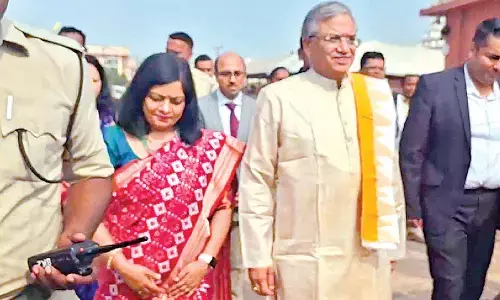Positive changes in power sector

The Economic Survey 2015-16 suggests that the new paradigm of surplus power sets the stage for continuing these reforms so that India can become ‘one market’ in power; the burden on industry can be relieved, allowing it to become internationally competitive as envisaged in “Make in India”; tariffs can be made simple and transparent,
Survey suggests possibility of achieving reasonably greater progressivity in tariff structures with lower tariffs for the poor
The Economic Survey 2015-16 suggests that the new paradigm of surplus power sets the stage for continuing these reforms so that India can become ‘one market’ in power; the burden on industry can be relieved, allowing it to become internationally competitive as envisaged in “Make in India”; tariffs can be made simple and transparent, avoiding proliferating end-use charges; and by taking advantage of the possibility of greater progressivity in rate-setting, charges for the poor could be reduced while generating more revenues
State Governments and State Regulators will have a key role to play, with helpful facilitation from the centre. The power sector is a perfect crucible for making effective the cooperative-competitive federalism experiment that is now India, the Survey adds
Several sweeping changes have taken place in the power sector which are as follows:-
- There has been record addition to generation capacity. 2014-15 marked the highest ever increase in generation capacity: 26.5 GW, much higher than the average annual addition of around 19 GW over the previous five years.
- Capacity enhancements in the power sector are unprecedented. These measures have helped to reduce India’s peak electricity deficit to 2.4 per cent, the lowest ever.
- There has been a comprehensive initiative to improve the health and performance of power distribution companies—UDAY, the Ujwal DISCOM Assurance Yojana
- Indian Railways is attempting to shift to open access for power purchase.
- Renewables have received a major policy push. Targets have been revised from 32 Gigawatts to 175 Gigawatts by 2022. In the latest round of auction under the National Solar Mission, tariff reached an all time low of Rs. 4.34 /KWh.
- Tantalising signs of moving to One Market in Power are becoming evident.
- Notwithstanding these major successes, the Economy Survey observes that the complexity of the Power Sector is such that daunting challenges remain. In particular:
- Complexity of tariff schedules prevents economic actors from responding sufficiently to price signals.
- Average tariffs in some cases are set below the average cost of supplying electricity.
- High industrial tariffs and variable quality of electricity adversely affects “Make in India”
- Price and non-price barriers come in the way of single-nationwide electricity prices through open access.
- Determination of progressive tariff schedules for domestic consumers.
The Survey discussed some longer term policy issues for the power sector which are as follows:-
- Power tariff schedules are currently complex. For example, in certain states there are separate tariffs for poultry farms, pisciculture, wetland farms (above and below a certain size), mushroom and rabbit farms, etc. By contrast, other energy products are characterised by a single price—or at most a few prices—across end users.
- Given high tariffs on industry, firms may be shifting from purchasing electricity from utilities to generating their own power.
- 47 per cent of firms report using a diesel generator
- Between 2006-07 and 2014-15, electricity procurement from utilities grew by 4.6 per cent annually, slower than the 9.3 per cent growth in self-generation.
- Cross-subsidy surcharges and non-price regulatory measures are key tools for balancing DISCOMS’ equity and access considerations, but they may also hinder the creation of a nationwide electricity market.
- Compared to other developing countries, India’s domestic power tariff schedules have greater scope for progressivity. Increases in tariffs for rich households can be achieved while maintaining or reducing tariffs for the poor.


















